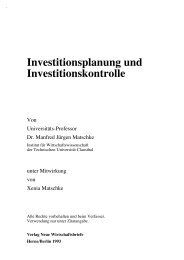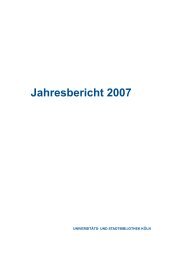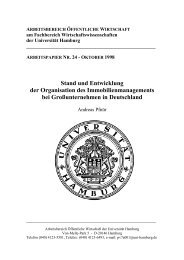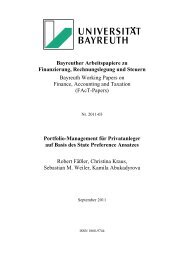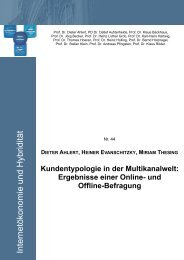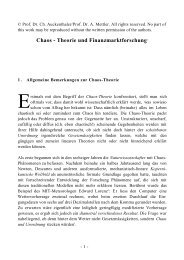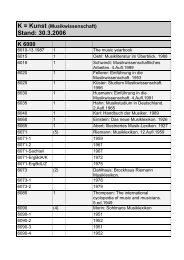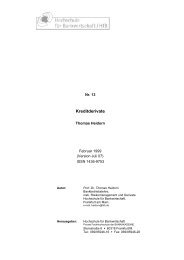FRANCE The
FRANCE The
FRANCE The
Create successful ePaper yourself
Turn your PDF publications into a flip-book with our unique Google optimized e-Paper software.
Trends<br />
Figure 4: Employment rates, Greece and EU 15, both sexes, 2001 (%)<br />
80<br />
70<br />
60<br />
50<br />
40<br />
30<br />
20<br />
10<br />
0<br />
summits (70%). <strong>The</strong> employment rate for older workers aged 55-64<br />
was estimated at 38%, slightly less than the average for EU-15<br />
(38.5% in 2001), but still 11.5 percentage points below target (50%<br />
by 2010). As Figure 4 shows, the employment rate in Greece lags<br />
behind the average of EU-15, for the age groups 50-54 and 55-59. In<br />
contrast, employment rates among older workers 60 years of age<br />
and above are higher in Greece than in EU-15. As noted earlier,<br />
employment rates vary distinctly between the sexes, with older<br />
women exhibiting much lower rates than men. Thus in 2001, the<br />
employment rate of older women (55-64) was 22.5%, 6.6 percentage<br />
points below the average for EU-15 and 15.5 percentage points<br />
below the equivalent rate for both sexes. As the rapid rise in female<br />
labour force participation took place in the 90s, however, these<br />
cohorts should raise the employment rates of older female workers<br />
within the next two decades.<br />
In the period between 1995 and 2001, the employment rate of older<br />
workers (55-64), fell in Greece by 3.0%. It should be noted that<br />
during the same period, the employment rate of older workers has<br />
increased in all other EU Member States, with the exception of Italy<br />
and Austria (for the EU as a whole the improvement was 2.6%).<br />
Although at this level of analysis, it is not clear what has caused the<br />
drop in the employment rate of older workers in Greece, it would<br />
appear that the reversal of the trend towards earlier retirement has<br />
already begun in most EU Member States.<br />
Details on the occupational structure and the sectoral distribution<br />
of older workers are generally scant6 . In general, the distribution of<br />
older workers between basic and more advanced sectors appears to<br />
be different from that of younger workers. In 1998, 60% of men aged<br />
55 to 59 were in employment and around 70% or more of those aged<br />
60 to 64 worked in agriculture, manufacturing, distribution and<br />
hotels and restaurants. In comparison, only 50% of the 25 to 49 age<br />
group is employed in one of these sectors. Further, it would seem<br />
that older workers are more concentrated in declining sectors than<br />
younger ones. According to estimates, 72% of those aged 55 to 59 in<br />
Greece<br />
EU 15<br />
50–54 55–59 60–64 65–69 70+<br />
Source: EUROSTAT, LFS<br />
work were employed in low growth or declining sectors (notably<br />
agriculture). <strong>The</strong> same holds for over 80% of those aged 60 to 64,<br />
compared with only 56% of those aged 25 to 497 .<br />
Another feature differentiating older people in employment from<br />
younger ones is the proportion of self-employment. As expected,<br />
the incidence of self-employment is much higher among older<br />
workers in relation to younger workers. Almost half (47%) of the<br />
55-64 age group in employment and 75% of 60 to 64 year-olds were<br />
self-employed in 1998. This finding is closely related to the<br />
importance of agriculture which employs a large share of older<br />
workers.<br />
Women older workers tend also to exhibit a higher incidence of selfemployment<br />
in relation to their younger counterparts. It is estimated<br />
that around 40% of women aged 55 to 64 in employment were selfemployed<br />
in 1998. Another significant proportion of women in the<br />
same age group (around 40%) was working as unpaid family workers.<br />
Consequently, those in employment working as wage or salary<br />
earners were just a minority (slightly above the 20% mark).<br />
<strong>The</strong> average level of educational attainment of older people is<br />
significantly lower than that of their younger counterparts. Some<br />
73.4% of those aged 55-64 had a low educational level (ISCED 2 or<br />
lower), as opposed to 27.5% of those aged 25 to 34. This finding<br />
partly reflects the increase in educational levels observed over time<br />
and partly the structure of economic activity in Greece and the high<br />
incidence of agricultural employment among older workers. <strong>The</strong><br />
cohort of workers aged 55-64 in the next two decades will be better<br />
educated than their counterparts today and rising educational<br />
attainment should help raise the absorption of larger groups of<br />
older workers in the future. However, in 2000, almost three quarters<br />
of workers aged 55-64 were classified as persons with low<br />
educational attainment in Greece, as opposed to just over half of<br />
their European counterparts, and this has certain implications.<br />
First, older workers are at risk of being excluded from employment<br />
in the services sector, which has been a major source of new job<br />
6 For a treatment of these issues, based on earlier data, see: Richardson, C., and T. Vasilainas (1996), “<strong>The</strong> employment of older people in Greece”, Proceedings of the<br />
Conference on Ageing and Society, EKKE, 1996.<br />
7 See: Employment in Europe, 1999.<br />
100 Spring 2003 | European Employment Observatory Review



